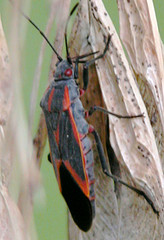Boisea trivittata (Say 1825)

B. trivittata adult on Acer negundo (boxelder) in Davenport, Iowa.
Range: Southern Canada, Eastern United States, Mexico, and Guatemala
Hosts: Acer grandidentatum (Bigtooth Maple), Acer negundo (Box Elder or Maple Ash), Acer saccharinum (Silver Maple, River Maple, or Soft Maple), Acer buergerianum (Trident Maple), and Sapindus saponaria (Soapberry)
Physical description: Entirely black in color except for the eyes, sides and center line of pronotum, margins of corium, coxae, and posterior ends of abdominal segments, which are all red.
May resemble: B. rubrolineata (veins of the corium are red)
Distribution
B. trivittata is thought to have originated in the Eastern United States and spread Northeast with the advent of human domiciliary overwintering habitats. It is also sparsely found in Mexico in the exact places that it overlaps with the A. negundo range.
Red markers = locations of collection sites
Blue region(s) of land = inferred range
3/4 inch = 1000 miles
Click here for an interactive version of this map.
References
G. and C. Bruce, pers. comm.
- Aldrich, J.R., Carroll, S.P., Oliver, J.E., et al. (1990) Exocrine secretions of scentless plant bugs: Jadera, Boisea and Niesthrea species. Biochemical Systematics and Ecology, 18, 369-376.
- Göllner-Scheiding, U. (1980): Revision der afrikanischen Arten sowie Bemerkungen zu weiteren Arten der Gattungen Leptocoris Hahn, 1833, und Boisea Kirkaldy, 1910. Dtsch. ent. Z., N.F. 27, 103-148. (English translation)
- Göllner-Scheiding, U. (1983): General-Katalog der Familie Rhopalidae (Heteroptera). Mitt. Zool. Mus. Berlin 59, 37-189.


